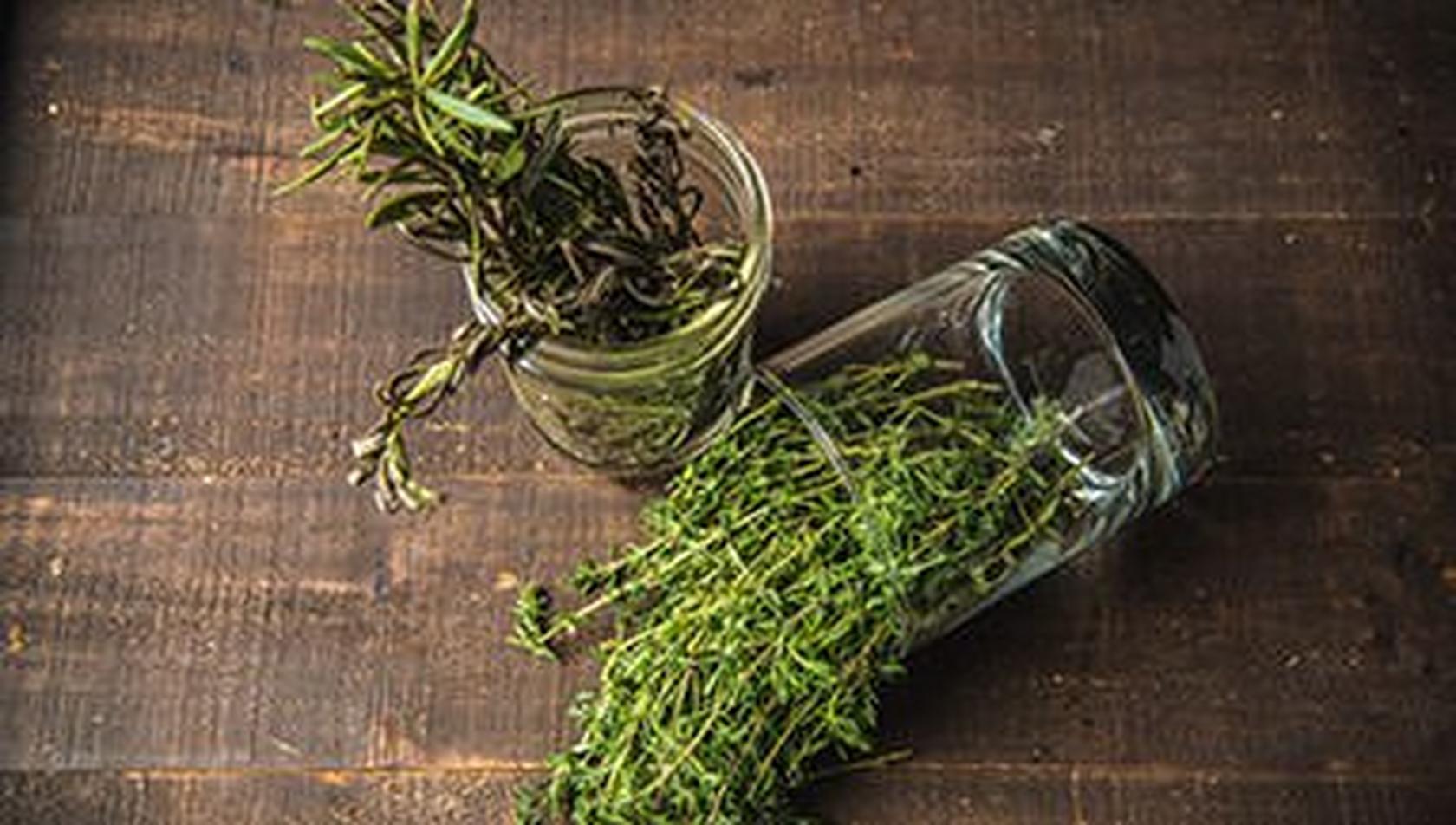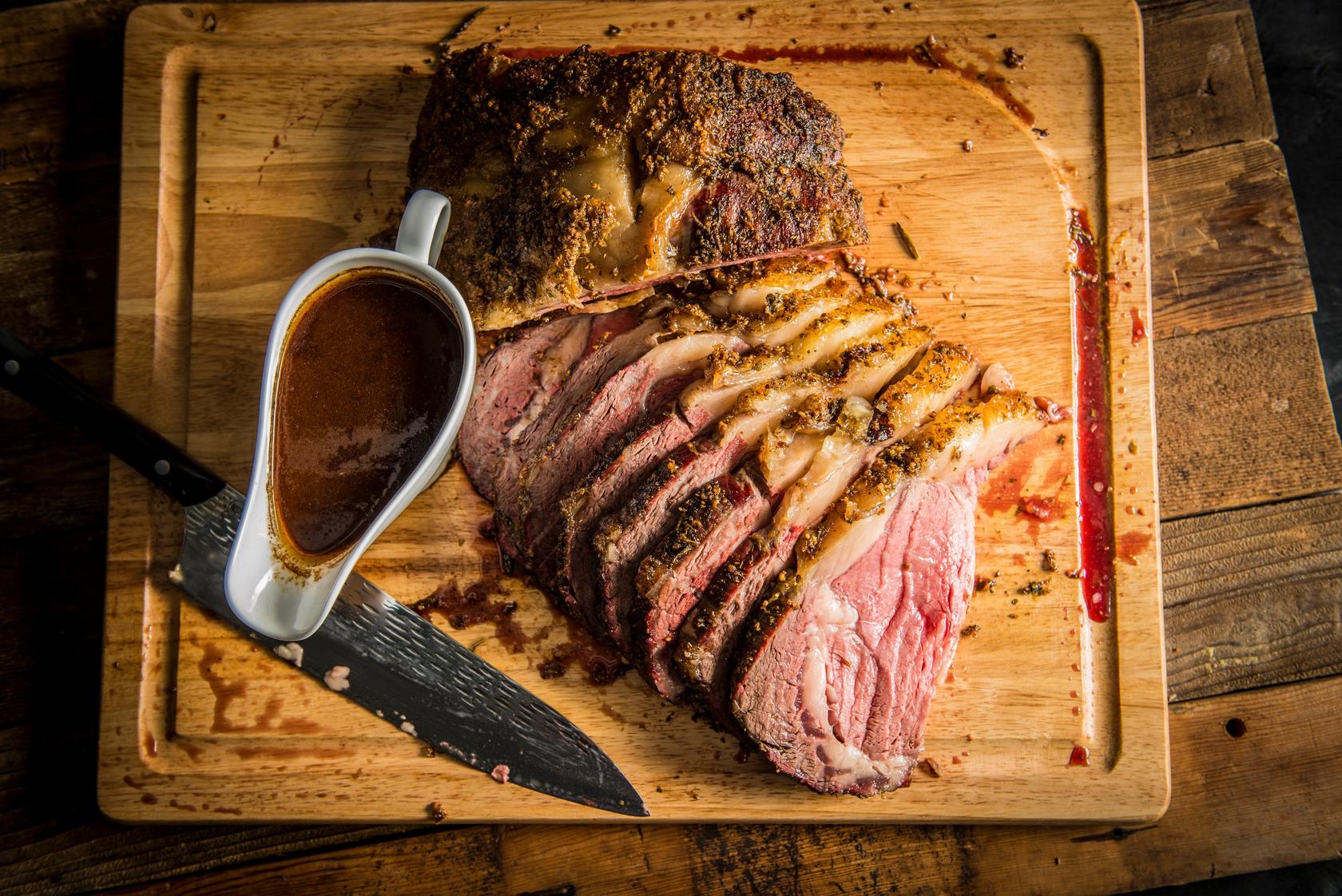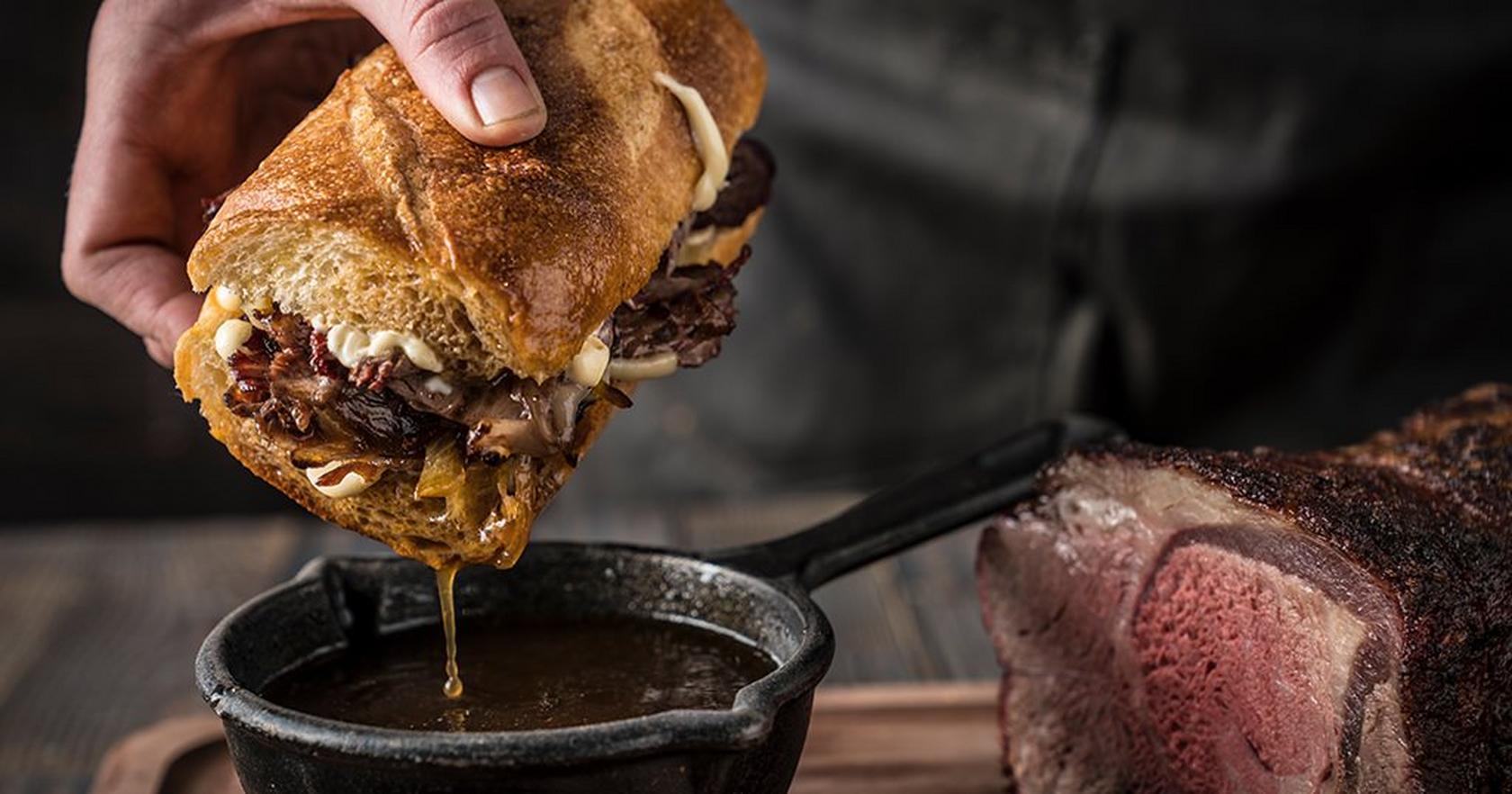?scaleFit=poi%26%24poi2%24&fmt=auto&w=1680&qlt=default)
Nothing goes together quite like a juicy prime rib and flavorful au jus recipe. When you make smoked prime rib in a roasting pan, you have an automatic head start on creating a thin but deeply flavored sauce for the meat, namely an au jus. With a name derived from the French phrase meaning "with juice," the sauce takes minutes to make but tastes like a lot of effort went into creating it. And while different recipes may use slightly different ingredients, there is a basic method for how to make an au jus for prime rib.
What is Au Jus?
At its most basic, an au jus consists of deglazing the roasting pan with wine and broth, but other flavorings are often added, too. The good news about making an au jus is that it’s easy and quick. So, while your roast rests, you can whip it up.
How is Au Jus Different From Gravy?
Both gravy and au jus (try saying it like “aww zhoo”) start with the flavorful drippings left in the roasting pan after cooking a Traeger rib roast. However, a gravy is thickened with flour or cornstarch while an au jus is most often not. If you have ever had a French dip sandwich (an excellent use for leftover prime rib), that sauce on the side is au jus. You might notice that it's more similar to beef stock than gravy since you are starting with cooked, not raw ingredients.
Which Roasts Are Good For Making Au Jus?
Traditional au jus is made from beef drippings (though a similar light sauce could be made from a roast lamb or even chicken or turkey). Whatever beef cut you roast can yield the start of an au jus, but it’s most popularly served with prime rib (aka standing rib roast). An au jus adds moisture and flavor to the beef slices but still allows the meat to be the star.
How To Make Au Jus For Prime Rib
While you can certainly cook a prime rib on the pellet grill directly on your Traeger grill grates, the best prime rib recipe meat is smoked over a roasting pan or a rimmed baking sheet if you want an au jus. That’s because, as mentioned, the sauce starts with the deeply flavored pan drippings or juices.
Start by transferring the roast itself to a cutting board and reserving the pan drippings. If you are lucky, you will have ample juices/dripping in the pan (some roasts are even cooked with some broth in the bottom of the pan as well). Some of the juices may be liquid and some may be solid and stuck to the bottom of the pan. (Those stuck-on juices are the really tasty bits since they have browned.) If you see there is a lot of liquid fat on top of the juice, pour it off being careful not to pour off the juice. (Alternatively, you can pour the juice into a fat separator and then pour just the juice back into the pan.)
Add more flavor with aromatics. You will be heating the drippings in the roasting pan over a couple of burners on the stove and adding ingredients to it to make the jus. Though adding aromatic vegetables to the jus is optional, it boosts its flavor. The chopped trio of onion, celery, and carrot known as mirepoix (“meer-pwah”) is a great place to start. How much to use can vary but a couple of small carrots, a couple of stalks of celery, and one onion will likely do the trick. You want to chop these to get the most flavor, but since you will be straining the vegetables out, it can be a coarse and careless chop.
Beyond the mirepoix, consider adding some garlic and herbs like bay leaf and fresh thyme. (And, of course, a sprinkling of Traeger Prime Rib Rub would also be delicious.) Add all of these to the pan and cook over medium-high heat, stirring and scraping up the browned bits on the bottom of the pan, until the vegetables begin to brown (but not burn). If it seems the juices are in danger of burning, add a little water or broth to the pan.

Deglaze with wine or broth or both. Adding wine to the sauce adds complexity and helps carry flavors, but you can just add broth. If using wine, choose a dry red wine (not an expensive one, but one you would actually drink). Add about 1 cup to the pan and then let most of it boil off. After that, add good quality beef stock, between 1 and 3 cups depending on the size of your roast and the number of people you’re feeding. A splash of Worcestershire sauce will add even more savory flavor.
Simmer, strain, and season. Simmer the sauce for at least 10 minutes to meld and concentrate its flavors. Strain it, season it to taste with salt and pepper, and serve alongside the sliced meat.
Prime Rib With Au Jus Recipes
Now that you know the basics of how to make a prime rib au jus, you can make your own whenever you make a prime rib on the pellet grill. However, there are also a handful of prime rib recipes on the Traeger site that have specific directions for an au jus. These include this delicious mayonnaise coated prime rib as well as this garlic crusted one.
Explore our other Traeger prime rib recipes for some inspiration:
- Best Prime Rib Recipe
- Traeger Prime Rib Recipe
- Rosemary Prime Rib
- Meat Church Prime Rib
- Salt Encrusted Prime Rib

How To Store Leftover Au Jus

If there’s any au jus left after the meal is served, hang on to it. If you are reheating leftover slices of meat, add some of the jus to keep them moist. You can also use the jus to serve with leftover prime rib to make a French Dip. Not only will this boost the flavor of a meat sauce but it would be delicious added to a risotto. It will keep, covered and refrigerated, for 3 days or frozen airtight for up to 3 months.
Herb Crusted Prime Rib with Au Jus
by Traeger Kitchen
9 Reviews
Prep Time
1 Hr
Cook Time
5 Hr
Serves
10
Pellets
Apple
Let’s face it: Prime rib is an extravagant, expensive cut of meat usually reserved for special occasions. You don’t want to mess it up, which is why this is the best prime rib recipe you’ll ever need. Mandy Tanner has crafted a flavorful and foolproof method to make the most of this show-stopping roast. She starts by salting the roast at least a day ahead to concentrate its savory, meaty flavor. Before cooking, she coats the roast with a flavored mayonnaise to lock in moisture and layers aromatic herbs between the bones and the meat. A final dusting of Traeger Prime Rib Rub boosts flavor and encourages a beautiful crust. By cooking it low and slow, she ensures a perfect medium rare every time.
Ingredients
Prime Rib and Jus
| 1 | 3- to 4-bone standing rib roast (10 to 12 lb) |
| kosher salt | |
| Traeger Prime Rib Rub, as needed | |
| 1 Bunch | sage |
| 1 Bunch | rosemary |
| 1 Bunch | thyme |
| 1 Bunch | parsley |
| 3 Tablespoon | mayonnaise |
| 2 Tablespoon | Dijon mustard |
| 2 Tablespoon | Worcestershire sauce |
| 3 Medium | carrots, cut into 1-inch pieces |
| 3 | celery stalks, cut into 1-inch pieces |
| 1 Large | yellow onion, cut into 1-inch pieces |
| 2 | bay leaves |
| 3 | garlic cloves, smashed |
| 1 Tablespoon | olive oil |
| 4 Cup | beef stock |
| freshly ground black pepper |
Horseradish Sauce (optional)
| 1/4 Cup | prepared horseradish |
| 2 Tablespoon | mayonnaise |
| 2 Tablespoon | sour cream |
| 1/2 Teaspoon | Traeger Prime Rib Rub |
1
Position a rack on a rimmed baking sheet. Place the rib roast on the rack and pat dry with paper towel. Season it all over with kosher salt and refrigerate uncovered for at least 24 hours and up to 48 hours. (The color will intensify and may be uneven, which is fine.)
2
When you are ready to cook, remove the prime from the refrigerator and let sit at room temperature for 1 hour. (You can prep the remaining ingredients in the meanwhile.)
3
With a long sharp knife held parallel to the rib bones, slice between the meat and bones, following the inner curve of the bones. Remove the bone plate from the roast in one piece with the bones attached. Sprinkle the rib plate with some Traeger Prime Rib Rub and reserve.
4
Set aside 1 sprig each of the sage, rosemary, and thyme for the au jus. Chop enough of the parsley to get 2 tablespoons. Then finely chop enough of the sage, rosemary, and thyme to get 1 tablespoon of each herb. Set the chopped herbs aside and reserve. Leave the remaining herbs whole.
5
Have ready 4 strands of butcher’s twine long enough to tie around the roast. In a small bowl, combine the 3 tablespoons mayonnaise, Dijon, and 1 tablespoon of the Worcestershire, and stir to combine. Coat the prime rib with a thin layer of the mayo mixture on all sides. Place the prime rib fat cap down on a work surface with the deboned side facing up. Spread the whole herb sprigs over the roast where the bones had been. Replace the rib plate. Using the butcher’s twine, tie the bones securely back onto the roast with snug loops spaced about 2 inches apart.
6
Flip the roast over and season the top with more Traeger Prime Rib Rub. Then sprinkle the reserved chopped herbs over the top and side.
7
In a roasting pan large enough to hold the roast, spread the carrots, celery, onion, garlic, bay leaves, and the reserved sprigs of sage, rosemary, and thyme out on the bottom of the pan. Drizzle with the olive oil. Place the rack over the vegetables, then place the roast bone-side down on the rack.
8
Preheat the Traeger with the lid closed to 250°F; this will take about 15 minutes.
9
Insert a leave-in thermometer into the thickest part of the roast, avoiding any bones or fat pockets, if possible. Place the roasting pan directly on the grill grate, close the lid and cook for 2 hours, which is about half the total cooking time. Toward the end of the two hours, combine the beef stock and the remaining 1 tablespoon of Worcestershire in a medium saucepan and bring it to a simmer.
10
Add the warmed beef stock mixture to the roasting pan with the vegetables (this will be used to make the au jus). Close the lid and continue to cook until the internal temperature of the prime rib is between 120°F to 125°F for medium rare (or cook it about 8 degrees less than your desired finished internal temperature for a different doneness). This will take 2 to 3 hours depending on the size of your roast, the weather, and your grill.
11
Meanwhile, if making the horseradish sauce, mix the horseradish, mayonnaise, sour cream, and Traeger Prime Rib Rub in a small bowl. Cover and refrigerate until ready to serve.
12
When the roast is done, transfer it rimmed baking sheet (to catch any juices) and tent with foil. Let rest for at least 40 minutes and up to 1 hour.
13
Meanwhile, strain the liquid in the roasting pan into a small saucepan, discarding the vegetables and bay leaves. Season to taste with salt and pepper and keep warm for serving.
14
To serve, remove the butcher’s twine from the prime rib. Separate the meat from the bones, discard the herb sprigs, and transfer the meat to a cutting board. Slice the roast against the grain (parallel to how the bones ran). You can also cut between the rib bones and serve the ribs along with the slices or keep as a cook’s treat. Serve warm with au jus and horseradish sauce, as desired. Enjoy!